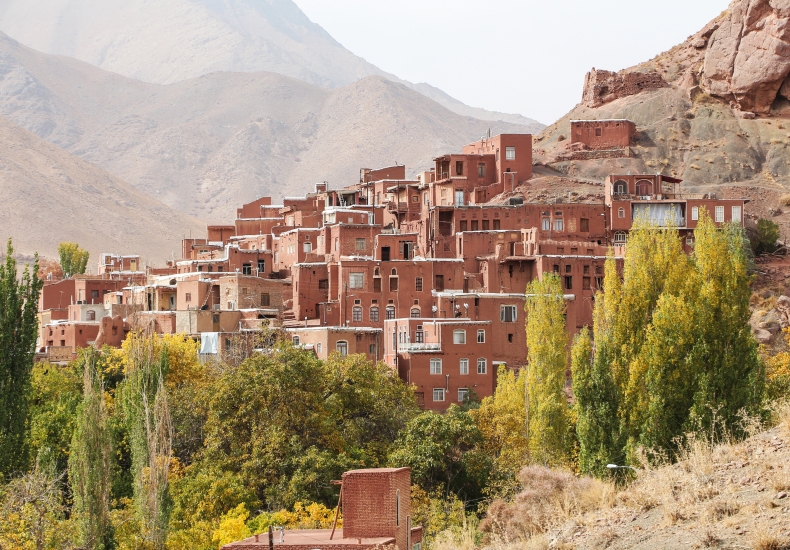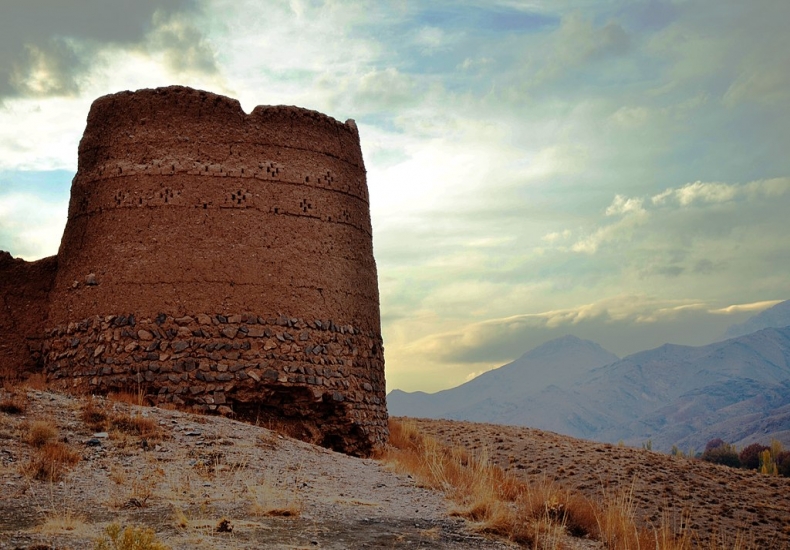Who said that “falling in love” is only limited to the feelings humans have for each other. You can fall in love with “things” and “places” as well as humans, or even more than that. Some places can occupy a place in your heart. Abyaneh village, a 1500-year old village, is one of those places. From its nature, and architecture to its freestanding people with their distinct customs.
On your trip to Abyaneh village, you will realize that civilization doesn’t always bring life, and distance doesn’t always mean falling behind. Sometimes in distance, the simplicity and purity remains, things that we are lacking the most in this era of complication. You may not be able to move there, but you can get to know the pure souls who live there and get in touch with their simplicity.
What is gathered here, is only an introduction to this village. We’ll then leave you to explore more in the village of Abyaneh, while you’re on your trip around Iran. Perhaps you will see things that we haven’t seen yet.
Abyaneh is a village in Barzrud Rural district, in the Central District of Natanz County, Isfahan province. This village is located 35 km from north east of Natanz county, on the foothills of Karkas Mountain (Karkas= Vulture). Abyaneh village is 2222 m above sea level and is one the highest residential areas in Iran. This village was formed in a valley, 20 km to the west of Natanz-Kashan road and 80 km from south west of Kashan city. Barzrud River runs in the south of Abyaneh village.
Abyaneh’s mild and moderate climate, gives it the characteristics of a favourable natural location. Fluxweed, Tragacanth, and Barberry shrubs are the traditional herbs that grow here.
This village with a population of about 301 people, was registered as one of Iran’s National Monuments in 1975.
In the local dialect, people call this village, Viuna. “Vi” means willow tree, and “Viyane” means “where willow trees grow or a garden of willow trees”, which refers to the time when Abyaneh was a garden of willow trees. Over the years “Abyaneh” is pronounced instead of “Viyane”, but the locals are still using its ancient name. There are no hard facts and evidences that point at a specific period or year that this village dates back to. But it’s estimated that it has over 1500 years of history, and this makes it one of the most ancient human habitats, that was built on the margins of Dasht-e-Kavir.
Historical buildings and monuments in Abyaneh village date back to Sassanid, Seljuk, Safavid and Qajar era. It is believed that during the Safavid era, the grandees chose Natanz as their summer quarter, but most of their comrades preferred Abyaneh to Nartanz, and spent their summers in Abyaneh.
Safavid architectural style manifests itself, in houses entirely built with red clay, adobe, bricks, wooden window frames made of walnut wood, and wooden balconies.
In this unique architecture, the roof of one house makes another house’s patio, that’s what gives this village the stair-shaped look. The villagers keep their livestock and winter food supply in cave looking storehouses built in the hills near the village.
Here is the answer: The Iron in the soil, gives a red and red ocher color to it, which is one of the main characteristics of Abyaneh village and its houses.
Another one of the famous attractions of this village is their clothing.
Walking in the alleys of Abyaneh, you will see men and women beautifying the village with their colourful costumes. A typical Abyaneh woman, covers her head with white floral kerchief and wears a hedge skirt on top of her pants or tights, which makes a beautiful garden of colours in front of the red houses.
Men wear black loose pants, Qaba (a long garment worn on top of a shirt), Giveh (Light cotton weaved shoes), and felt hats. During cold times of year, they wear special warm clothes, called “Arkhalegh”, which resembles a long coat.
People of Abyaneh have hold on tight to their traditions, which might be due to a various number of reasons, reasons regarding its geographical location, less communication with other cities and villages due to being mountainous which may have led to a bit of isolation.
This tradition preservation has caught many attentions to itself and has invited many tourists to visit this village.
People’s living is dependent on farming, gardening and animal husbandry. Seven Qanats provide water for wheat and barley farms, potato farms and various fruit gardens such as apples, pears, plums, apricots and walnuts.
Women used to provide for themselves, by weaving “Giveh”, traditional light cotton shoes. Today carpet weaving has become very famous among the villagers.
People of Abyaneh speak Farsi with an accent, specific to the people of Abyaneh.
Among the historical places that you need to visit, there are, mosques, shrines, cemetery, and a fire temple. We name a few of the mosques, plus some other historical place.
Mian-deh Mosque (also known as Abyaneh Jame Mosque)
This mosque is located in “Miandeh” neighbourhood and near the water reservoir. It is one of the oldest mosques of Abyaneh, with two bedchambers, walls are made with adobe and mud, short ceiling, wooden altar embroidered with floral patterns, dates back to the 11th century. The bearer of this mosque belongs to Seljuk era.
Hajatgah Mosque (Hajat: wish Gah: placeè Place you can pray to god to make your wishes come true)
This mosque belongs to Ilkhanid dynasty, and dates back to 14th century. The unique architecture of this mosque and constant breeze makes it a pleasant place to sit for a while. It is said that, the entrance door of this mosque is one of the oldest doors in Abyaneh village.
Fire temple of Abyaneh
This fire temple is the oldest historical monument in Abyaneh, and is located in Abyaneh’s main alley. It is believed to be a Zoroastrian fire temple.
Shahzadeh Isaac and Shahzadeh Yahya shrine (Shahzadeh: Prince)
Hinza Shrine
Hinza shrine is a pilgrimage site. Locals believe that BiBi Zobeydeh, the daughter of seventh Shia Imam, took refuge in this room and was granted shelter by the people of Abyaneh. Others say this site was once a temple dedicated to Anahita, Persian Goddess of water. Locals believe that miracles happen at the site.
Castles of Abyaneh
There are remains of three defensive fortresses at the top of the village. Each of them belonged to three neighbourhoods. The one in the south west of the village dates back to about 200 years ago.
Abyaneh Cemetery
The stones in this cemetery have rectangular shapes. A tomb stone with a carved “Comb” on it, belongs to a deceased woman.
There’s no preferred time to travel to Abyaneh, as it’s spectacular in every season, but during May, due to rosewater extraction ceremony in Kashan, it’s full of visitors. During the Persian New Year’s holiday, it’s very crowded.
Best way to travel to Abyaneh village, is to take tours to Abyaneh. If you’re staying in one of the hotels in Kashan, ask the reception to suggest you some tours to the village. Iran Negin Travel as an Iran Tour Operator can arrange your trip to Iran and to any part of it from the origin, any border or city you want to be started from. If you’re travelling on your own, with a group, or with some Iranian friends of yours and you’re not travelling with a tour, you are most likely travelling with a personal car, so you’ll have the option to stay as many nights as you want in the village’s hotels. No cars are allowed inside the village, so you must park your car, and start enjoying the rest of your Abyaneh journey, walking on those beautiful feet of yours.
Two roads take you to the village: Kashan-Isfahan and Kashan-Natanz.
Abyaneh Village is the preffered destination by the history and trekking activity lovers. Many tourists who visit Iran, want to have one day excursion to Kashan and Abyaneh. This Incredible village is easily reachable by our tours and services.
Iran Negin Travel, as an Iran tour operator offers among with Iran tourism services such as Iran visa, Iran hotel booking and etc. , Iran tours packages through which the passengers can discover Iran as they desire. As a very common request, Iran cultural tours packages and Iran daily tours. You can chose among our Iran tours packages and add Abyaneh to your program and enjoy your trip to Iran.
Our team is eagerly ready to provide you all the services from Iran visa to Iran tours packages. Don't forget to contact us!
Carry a camera with you to capture the beauty of this village, but one very important thing to note is that, locals do not like to be photographed without permission, so make sure you ask them before you do so.
Some locals sell things such as handicrafts, local fruit rolls and dried apricots for a living. We can kindly ask you to buy things from them, as this will make them happy in so many different ways. You can provide your bread supply, from the one and only bakery in the village.
Some locals rent Abyaneh’s local costumes to the visitors. You can borrow one and take pictures with them. It’ll definitely a nice experience to wear the floral kerchief, colourful skirts, men’s loose pants and Givehs, at least once.



24/7
200.000 IRR